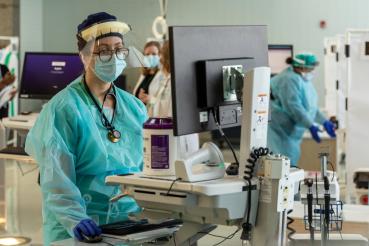You’ve hunted down fresh school supplies, filled out your school’s online forms and even stocked the fridge with your kid’s favorite lunch items. Yet during the back-to-school rush, it’s easy to miss some key steps that could help keep your child or teen safe from COVID-19 this season.
We asked Vrinda Kumar, MD, a pediatrician at Rush Copley Medical Center, to offer a checklist for parents so they can protect their school-age kids against the virus this fall.
✓ Get kids vaccinated and boosted against COVID-19 if they are eligible.
“Once kids go back to school, they naturally are going to be exposed to COVID-19 as well as other illnesses,” Kumar says. “COVID-19 vaccination can keep kids out of the hospital and hopefully reduce the number of missed school days.”
The Centers for Disease Control and Prevention recommends that everyone 6 months and older get vaccinated against COVID-19. CDC also recommends one booster for everyone 5 years and older, if they are eligible. CDC also advises that people 12 and older who are moderately or severely immunocompromised get two boosters.
You can use CDC’s COVID-19 booster tool to find out if your child is eligible for a booster based on their age, type of primary vaccine (Pfizer-BioNTech or Moderna), previous boosters and whether they are immunocompromised.
“Getting boosted before the school year starts will give kids extra protection from severe illness,” Kumar says.
Want some extra credit? Kumar also suggests scheduling a flu shot this fall. CDC recommends an annual flu shot for everyone 6 months and older, ideally before the end of October.
All RUSH hospitals currently offer the COVID-19 vaccine for kids. To schedule an appointment, call (888) 352-7874 (RUSH).
✓ Know your COVID-19 community level.
The CDC tracks certain metrics like COVID-19 hospitalizations and new COVID-19 cases to assign a COVID-19 community level to your county. Knowing whether your community level is low, medium or high can help you take added precautions like masking to reduce the spread of disease.
As of the second week of August, COVID-19 community levels were high in Cook County and neighboring counties in Illinois. Counties across the United States were also dealing with high levels, largely because of the highly transmissible BA.5 omicron subvariant.
✓ Consider masking even if it is not required by your school.
The CDC has eased some of its guidelines for schools across the country this fall. School districts across Illinois may choose to require masks at their discretion. Given the recent surge of COVID-19, leaders at Chicago Public Schools strongly recommend that kids wear masks in school even though masks are not required. That is because masking provides an additional layer of protection against the virus that is still active throughout Chicagoland and the rest of the country.
According to Kumar, “masking decreases the risk of infection and slows down the spread of infection, and wearing a mask poses no danger or risk to one’s health.” Although the effectiveness of masking declines when others around you aren’t wearing masks, the practice still offers benefits, she adds.
The American Academy of Pediatrics says indoor masking is beneficial for youngsters 2 and older, especially if they:
- Are not immunized
- Are immunocompromised
- Live with other family members who have a higher risk for severe disease or are not immunized
- Attend school in a community where the COVID-19 transmission is high
The best mask for your child is one that fits over the nose and chin. It should be comfortable, so your child is less likely to remove it.
✓ Take steps to protect your young athletes at school.
Pediatricians like Kumar recognize the value that school sports have for kids. But parents should be aware that activities that involve prolonged, close contact with others do play a role in transmission. “Close contact and likely exposure to COVID-19 are inevitable with certain sports, so the best thing we can do to protect our kids against severe disease and hospitalization is to get them vaccinated,” Kumar says.
According to AAP, outdoor sports are less risky than activities in poorly ventilated indoor facilities, although recent variants appear to be more transmissible outdoors than previous variants. In many cases, the virus spreads during off-the-field social activities, like shared meals and carpools.
Sports are not the only activities that can raise COVID-19 risks at school. Other potentially risky activities include band, choir and theater, according to CDC.
As a parent, it’s your decision whether you allow your child to participate in these activities. If you aren’t sure, Kumar recommends talking with your pediatrician.
✓ Talk to kids about practicing safe behaviors at school.
Getting kids to listen can sometimes be a challenge, but coaching your kids on how to be safe at school doesn’t have to take much time or effort. Kumar offers these pointers:
- Send young people to school with a well-fitted mask and ask them to wear it, especially if a classmate seems sick.
- Encourage kids of all ages to wash their hands frequently or use hand sanitizer throughout the day.
- Remind kids to avoid touching their face, eyes and mouth.
- Discourage them from taking bites or sips from other kids’ food and drinks.
Modeling the same habits in your own life can help you teach your kids how to stay healthy.
✓ Keep youngsters at home if they are sick.
“If your child has any symptoms of illness — such as fever, runny nose, cough, vomiting or diarrhea — keep them at home and call your doctor and school nurse for further guidance,” Kumar says.
If you think your child may have COVID-19 specifically, don’t send them to school until you get their test results and know for sure.
For the school year ahead, the best way to reduce anxiety about symptoms is to make sure your kid is up to date on their vaccines.
“Prevention is the key to keeping our kids healthy, safe and in school,” Kumar says.
RUSH On Demand can give your child a back to school or daycare note if they have recovered from an illness (COVID-19, flu and more). In less than 20 minutes, you can connect from home with a RUSH provider through a video visit. You can also choose a time for your visit that works best for you. Learn more and start a visit today.




